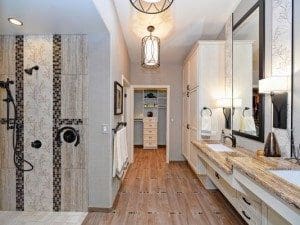
Nothing beats home. It’s where many of us want to stay for as long as possible, even as we age.
And, yet, the varied aspects of senior life — impaired vision, arthritis and limited mobility
— can make staying home a challenge. Thanks, however, to smart modifications — like adding grab bars in the bathroom or improving lighting in a hazardous hallway — the concept of “universal design” or "aging in place" is more possible now than ever.
Once something of a buzzword, “universal design” is now a specialty designation in the homebuilding industry. In fact, remodeling professionals with the National Association of Home Builders (NAHB) have joined together with AARP, the NAHB’s 50+ Housing Council and Home Innovation Research Labs to develop the CAPS, or Certified Aging-In-Place Specialist, program. The designation is not a requirement for remodelers, but those in CAPS undergo training and learn how to build tasteful, barrier-free living spaces suited to the needs of older adults.
“They know how to talk to a family about what they’re looking for in a remodel, and they also have the science behind it,” said Nissa Hiatt, a NAHB spokesperson. “The work they do doesn’t just keep you safe, it looks great, too.”
Universal design is primed to "boom"
Bonnie Lewis, owner of 55+ TLC Interior Design, LLC, in Scottsdale, a CAPS member and a senior living specialist, said universal design is going to become even more prevalent as Baby Boomers age. And the best advice she can give to Boomers — or anyone 50 and older — is to start preparing now for the future.
“A lot of times, people wait until something happens, and a lot of times, that’s too late, so you have to go into a skilled nursing center or some kind of community” because your home cannot accommodate your injury, be it temporary or permanent, she said, adding that waiting until an event happens causes problems, so it’s better to be preventative.
“Good design makes life better.”
Of course, most of us never think anything’s going to happen, she said. Which is why she often suggests making universal design modifications during standard remodeling jobs. Such tweaks don’t cost much more, and since work is already underway, there’s no better time, she said. In addition, many universal design modifications don’t just aid seniors; they may be helpful, for example, to anyone with a disability, regardless of age.
Smart investment, hard sell
But that doesn’t mean modifications are always an easy sell. Lewis, for instance, remodeled a couple’s bathroom and suggested they install grab bars. It was a preventative measure; the bars were not necessary under current conditions. But the homeowners resisted until Lewis reminded them it was a smart investment and told them it’s not as if the bars can be bolted into place in a matter of minutes.
“You can’t just add grab bars,” Lewis said. “The wall has to be able to support 250 to 500 pounds, so it has to be prepared behind the drywall. And that’s what we did, in this case. So when they do decide to add grab bars, they can tell the installer, ‘They go here.'”
Other areas in a home that need often can use some universal design modifications. Lewis and Jeff Gorszczyk, division manager for Cook Remodeling in Mesa and a CAPS member, listed these seven tips for universal design:
1. Cabinetry: Shelving may need to be lowered so it’s more accessible, and you may want to add more base cabinets and drawers instead of doors. Relocating the microwave from above the range to a base cabinet also may help. One client requested a customized pocket door under the kitchen sink, so the standard doors wouldn’t get in the way.
2. Appliances: A stove with controls at the front is more accessible than models that have the controls at the back; a refrigerator with a French door-opening is typically more accessible than other styles.
3. Materials: Contrasting colors and a variety of textures and patterns can provide visual cues for someone whose vision is impaired. “Colors help your psyche,” Lewis said.
4. Flooring: Falls are a huge problem for older clients, so buy flooring that minimizes risk. Natural travertine, for instance, can catch the heel of a shoe, walker or cane. Try smooth tile.
5. Rugs: Get rid of them. They are a tripping hazard, as well as a slip-and-fall hazard.
6. Electrical: Modifications as small as moving the garbage disposal switch – which is usually on the back wall of the kitchen near the sink – can make a big difference, as can lowering wall-mounted light switches.
7. Doors: The front door can usually accommodate a wheelchair, but many interior doors, particularly those that lead from a bathroom to a bedroom, often need to be widened for easier access. On another note, replacing traditional door knobs with lever-type handles can make worlds of difference for someone with arthritis.
And don’t think it’s strictly older homes that can use these changes, Gorszczyk said. It’s not.
“We’ve actually gone into homes, after the customer closes on a new build, because the (homebuilder) wouldn’t take care of the modifications,” he said. “I wish more builders would plan for this.”

